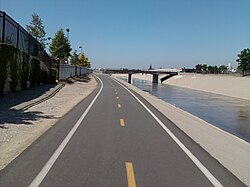| Rio Hondo Bike Path | |
|---|---|
 Between El Monte Airport and Rosemead Blvd | |
| Length | 1.6 mi (2.6 km) |
| Location | Los Angeles County |
| Use | Active transportation, road biking, walking, dogs on leash |
| Difficulty | Easy |
| Surface | asphalt |

The Rio Hondo Bike Path is a bicycle path that parallels the Rio Hondo (creek) through the San Gabriel Valley, in eastern Los Angeles County, California. [1] The path is gently graded, and has sections with more greenery and mature trees than other bicycle paths in the area. [1] Rio Hondo means deep river in Spanish. [2]
Contents
The proximity of the Rio Hondo Bike Path to the central regional transit hub at the El Monte station, including the Los Angeles Metro Busway J Line, makes it one of the most accessible routes to access a variety of bike paths and local parks.